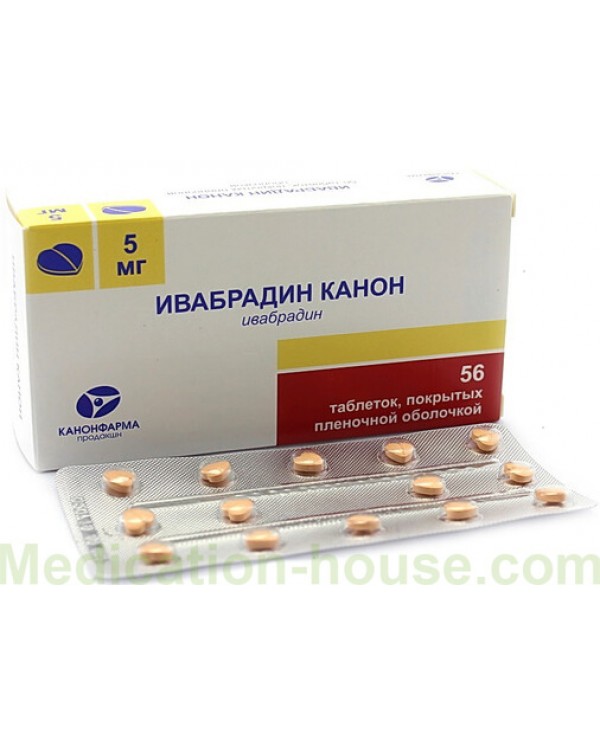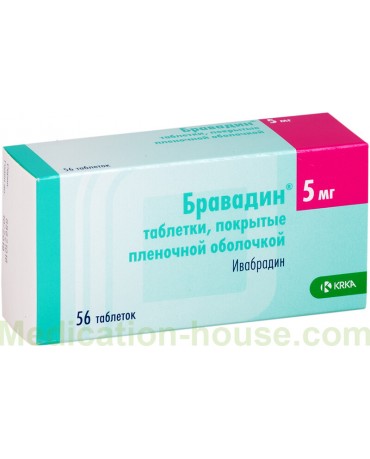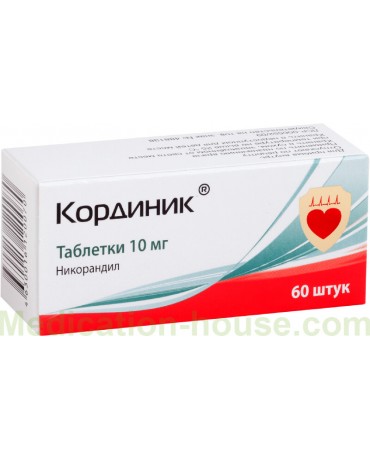Ivabradine user manual
You can buy Ivabradine on this page
Pharmachologic effect
Antianginal remedy. The mechanism of action consists in selective and specific inhibition of the If channels of the sinus node, which control spontaneous diastolic depolarization in the sinus node and regulate heart rate.
The drug has a selective effect on the sinus node, without affecting the time of impulses along the intra-atrial, atrioventricular and intraventricular pathways, as well as myocardial contractility and ventricular repolarization.
The main pharmacodynamic property of the drug is a specific, dose-dependent decrease in heart rate. Analysis of the dependence of the magnitude of the decrease in heart rate at a dose of more than 20 mg 2 times / day revealed a tendency to achieve a plateau effect, which reduces the risk of developing severe, poorly tolerated bradycardia (heart rate less than 40 beats / min).
When used in recommended doses, the decrease in heart rate is approximately 10-15 beats / min at rest and during exercise. As a result, the work of the heart decreases and the myocardial demand for oxygen decreases.
Ivabradine is also able to interact with the Ih channels of the retina, similar to the If channels of the heart. The Ih channel is involved in the appearance of a temporary change in the resolution of the visual system, because reduces the retinal response to bright light stimuli. Under provocative circumstances (for example, a rapid change in brightness), ivabradine partially inhibits the electrical impulse Ih, which sometimes leads to the appearance of light sensations (phosphenes) in some patients, which are described as a short-term sensation of increased brightness in a limited part of the visual field.
Against the background of the use of the drug in patients with CHF II-IV functional class according to the NYHA classification with LVEF less than 35%, a clinically and statistically significant decrease in the relative risk of complications (the frequency of deaths from cardiovascular diseases and a decrease in the frequency of hospitalizations due to increased symptoms of the course) CHF) by 18%. The absolute risk reduction was 4.2%. A pronounced therapeutic effect was observed 3 months after the start of therapy.
Indications
Treatment of stable angina pectoris in patients with normal sinus rhythm: with intolerance or contraindications to the use of beta-blockers; in combination with beta-blockers with inadequate control of stable angina pectoris against the background of the optimal dose of beta-blocker.
Chronic heart failure: to reduce the incidence of cardiovascular complications in patients with chronic heart failure, with sinus rhythm and heart rate of at least 70 bpm.
Method of application, course and dosage
The average recommended starting dose of ivabradine is 5 mg 2 times / day (10 mg / day). Depending on the therapeutic effect, after 3-4 weeks of use, the dose can be increased to 7.5 mg 2 times / day (15 mg / day).
If, during therapy, the heart rate decreases to values less than 50 beats / min or symptoms associated with bradycardia (such as dizziness, fatigue, or arterial hypotension) occur, a lower dose should be selected; if necessary, the dose can be reduced to 2.5 mg 2 times / day. If the heart rate remains less than 50 beats / min and the symptoms of bradycardia persist, then treatment is stopped.
In elderly patients, it is recommended to start treatment with an initial dose of 2.5 mg 2 times / day. In the future, it is possible to increase the daily dose depending on the patient's condition.
Drug interactions
When combined with ivabradine, drugs that increase the QT interval (quinidine, disopyramide, bepridil, sotalol, ibutilide, amiodarone, pimozide, ziprasidone, sertindole, mefloquine, halofantrine, pentamidine, cisapride, erythromycin IV), possibly an increase in the frequency of heart rate lengthening of the QT interval. If necessary, simultaneous therapy should be carefully monitored ECG indicators (such combinations are not recommended).
The drug is metabolized in the liver with the participation of the isoenzyme CYP3A4 and is a very weak inhibitor of this isoenzyme. Ivabradine has no significant effect on metabolism and plasma concentration of other substrates (strong, moderate and weak inhibitors) of cytochrome CYP3A4. At the same time, inhibitors and inducers of the CYP3A4 isoenzyme can interact with ivabradine and have a clinically significant effect on its metabolism and pharmacokinetic properties. It was found that inhibitors of the CYP3A4 isoenzyme increase, and inducers of the CYP3A4 isoenzyme reduce the plasma concentrations of ivabradine. An increase in the concentration of ivabradine in blood plasma may increase the risk of developing severe bradycardia.
Concomitant use with strong inhibitors of the CYP3A4 isoenzyme, such as antifungal agents of the azole group (ketoconazole, itraconazole), macrolide antibiotics (clarithromycin, oral erythromycin, josamycin, telithromycin), HIV protease inhibitors (nelfinavir, for rhyodonavir plasma ivabradine and the risk of developing excessive bradycardia.
The simultaneous use of the drug and moderate inhibitors of the CYP3A4 isoenzyme diltiazem or verapamil (drugs that slow down the heart rate) in healthy volunteers and patients was accompanied by an increase in the AUC of ivabradine by 2-3 times and an additional decrease in heart rate by 5 beats / min. These combinations are not recommended.
Inducers of the CYP3A4 isoenzyme, such as rifampicin, barbiturates, phenytoin and herbal preparations containing St. John's wort (Hypericum perforatum), when used together with ivabradine, can lead to a decrease in the blood concentration and activity of ivabradine (the use of the drug in a higher dose may be required). With the combined use of ivabradine and preparations containing St. John's wort, a twofold decrease in the AUC of ivabradine was noted. During the period of using ivabradine, you should reduce the intake of herbal preparations containing St. John's wort.
The use of ivabradine in combination with other moderate inhibitors of the CYP3A4 isoenzyme (for example, fluconazole) is possible provided that the resting heart rate is more than 60 beats / min. The recommended initial dose of ivabradine is 2.5 mg 2 times / day. Heart rate control is required.
The drug should be used with caution with non-potassium-sparing diuretics (thiazide and "loop" diuretics). hypokalemia can increase the risk of developing arrhythmias. Since ivabradine can cause bradycardia, the combination of hypokalemia and bradycardia is a predisposing factor for the development of severe arrhythmias, especially in patients with long QT syndrome, both congenital and induced by exposure to any substances.
With the use of grapefruit juice against the background of the use of ivabradine, an increase in the concentration of ivabradine in the blood was noted by 2 times. During the period of ivabradine therapy, the intake of grapefruit juice should be reduced.
Application during pregnancy and lactation
Contraindicated for use during pregnancy and lactation (breastfeeding).
Side effect
From the senses: very often - changes in light perception (photopsia); often - blurred vision; infrequently - vertigo; unspecified frequency - diplopia, visual impairment.
From the side of the cardiovascular system: often - bradycardia, AV-blockade of the 1st degree, ventricular extrasystole, short-term increase in blood pressure; infrequently - palpitations, supraventricular extrasystole; very rarely - atrial fibrillation, AV block II and III degree, SSS; unspecified frequency - a marked decrease in blood pressure, possibly associated with bradycardia.
From the digestive system: infrequently - nausea, constipation, diarrhea.
From the side of the central nervous system: often - headache (especially in the first month of therapy), dizziness, possibly associated with bradycardia; unspecified frequency - syncope, possibly associated with bradycardia.
From the respiratory system: infrequently - shortness of breath.
Contraindications for use
Bradycardia (resting heart rate below 60 beats / min before treatment); cardiogenic shock; acute myocardial infarction; severe arterial hypotension (systolic blood pressure below 90 mm Hg and diastolic blood pressure below 50 mm Hg); severe liver failure (more than 9 points on the Child-Pugh scale); SSSU; sinoatrial blockade; chronic heart failure of III and IV functional class according to NYHA classification; the presence of an artificial pacemaker operating in a constant stimulation mode; unstable angina; AV block III degree; pregnancy; lactation period (breastfeeding); children and adolescents up to 18 years old; simultaneous use with strong inhibitors of the CYP3A4 isoenzyme, such as antifungal agents of the azole group (ketoconazole, itraconazole), antibiotics of the macrolide group (clarithromycin, oral erythromycin, josamycin, telithromycin), HIV protease inhibitors (nelfinavir and nef ritonodavir); hypersensitivity to ivabradine.
Special instructions
It should be used with caution in moderate hepatic impairment (less than 9 points on the Child-Pugh scale); severe renal failure (CC <15 ml / min); congenital lengthening of the QT interval; simultaneously with taking medications that prolong the QT interval (risk of developing severe ventricular arrhythmias of the "pirouette" type); while taking moderate inhibitors and inducers of CYP3A4 isoenzymes and grapefruit juice; with AV block II degree; recent stroke; retinal pigment degeneration (retinitis pigmentosa); arterial hypotension; chronic heart failure IV functional class according to NYHA classification; while taking slow calcium channel blockers that slow heart rate, such as verapamil or diltiazem; simultaneously with taking non-potassium-sparing diuretics.
Ivabradine is not effective for the treatment or prevention of arrhythmias. Its effectiveness decreases against the background of the development of tachyarrhythmias (for example, ventricular or supraventricular paroxysmal tachycardia).
Not recommended for use in patients with atrial fibrillation (atrial fibrillation) or other types of arrhythmias associated with sinus node function.
During therapy with ivabradine, it is recommended to regularly monitor the patient's condition for the development of atrial fibrillation (paroxysmal or constant). With clinical indications (for example, worsening of angina pectoris, the appearance of a sensation of palpitations, irregular heart rhythm), the ECG should be monitored regularly.
The risk of developing atrial fibrillation may be higher in patients with chronic heart failure taking the drug. Atrial fibrillation was more common among patients who took amiodarone or class I antiarrhythmic drugs simultaneously with ivabradine.
Before deciding on the use of ivabradine, the course of heart failure should be stable. Patients with chronic heart failure and intraventricular conduction disorders (left or right bundle branch block) and ventricular dyssynchrony require constant medical supervision.
It has not been proven that there is an increase in the risk of developing severe bradycardia while taking ivabradine while restoring sinus rhythm during pharmacological cardioversion. However, due to the lack of sufficient data, if possible to delay elective cardioversion, ivabradine should be discontinued 24 hours before it.
A decrease in heart rate due to the drug administration can aggravate the prolongation of the QT interval, which, in turn, can provoke the development of a severe form of arrhythmia, in particular, polymorphic ventricular tachycardia of the "pirouette" type.
Influence on the ability to drive vehicles and mechanisms
During the treatment period, the patient should exercise caution when engaging in potentially hazardous activities that require a high speed of psychomotor reactions in situations where sudden changes in illumination may occur, especially at night.
Application for impaired renal function
It should be used with caution in patients with CC below 15 ml / min.
Application for violations of liver function
Contraindicated in severe hepatic impairment. It should be used with caution in patients with moderate hepatic impairment.
Application in children
Not recommended for use in children and adolescents under the age of 18.
Terms of sell
You don't need a prescription to buy Ivabradine.



